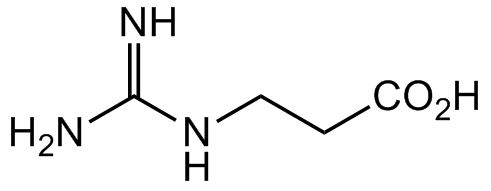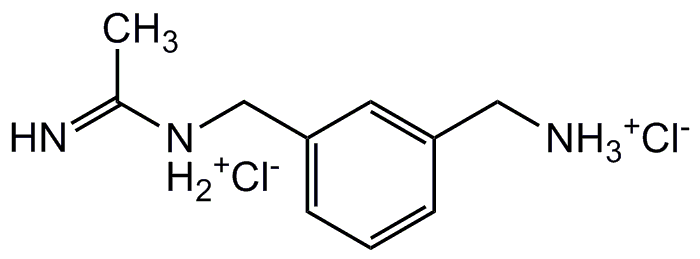
Chemical Structure
3-Guanidinopropionic acid
AG-CR1-3678
CAS Number353-09-3
Product group Chemicals
Estimated Purity>98%
Molecular Weight131.1
Overview
- SupplierAdipoGen Life Sciences
- Product Name3-Guanidinopropionic acid
- Delivery Days Customer10
- CAS Number353-09-3
- CertificationResearch Use Only
- Estimated Purity>98%
- Hazard InformationWarning
- Molecular FormulaC4H9N3O2
- Molecular Weight131.1
- Scientific DescriptionChemical. CAS: 353-09-3. Formula: C4H9N3O2. MW: 131.1. Synthetic. Competitive creatine uptake inhibitor. Creatine analog that alters skeletal muscle energy expenditure. Thermogenesis inhibitor. Inhibitor of energy expenditure through reduction of ATP. AMPK stimulator and PGC-1alpha activator. Reduces cellular ATP, creatine and phosphocreatine levels, consequently stimulating AMP-activated protein kinase (AMPK) and activating PPARgamma coactivator 1alpha (PGC-1alpha). Evokes a shift from glycolytic to oxidative metabolism, increased cellular glucose uptake and increased fatigue tolerance. Ameliorates hyperglycemia in animal models of non-insulin-dependent diabetes (NIDDM). Improved insulin sensitivity and promoted weight loss selectively from adipose tissue. Studied for potential use during protein refolding as an anti-aggregatory molecule similar to L-arginine. - Competitive creatine uptake inhibitor. Creatine analog that alters skeletal muscle energy expenditure. Thermogenesis inhibitor. Inhibitor of energy expenditure through reduction of ATP. AMPK stimulator and PGC-1alpha activator. Reduces cellular ATP, creatine and phosphocreatine levels, consequently stimulating AMP-activated protein kinase (AMPK) and activating PPARgamma coactivator 1alpha (PGC-1alpha). Evokes a shift from glycolytic to oxidative metabolism, increased cellular glucose uptake and increased fatigue tolerance. Ameliorates hyperglycemia in animal models of non-insulin-dependent diabetes (NIDDM). Improved insulin sensitivity and promoted weight loss selectively from adipose tissue. Studied for potential use during protein refolding as an anti-aggregatory molecule similar to L-arginine.
- SMILESNC(NCCC(O)=O)=N
- Storage Instruction-20°C,2°C to 8°C
- UNSPSC12352200


![RGX-202 [353-09-3]](https://www.targetmol.com/group3/M00/02/87/CgoaEGY7Nh-EOgLxAAAAAP1TD-U975.png)
